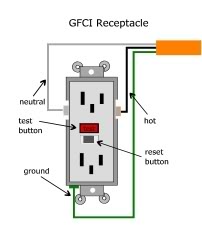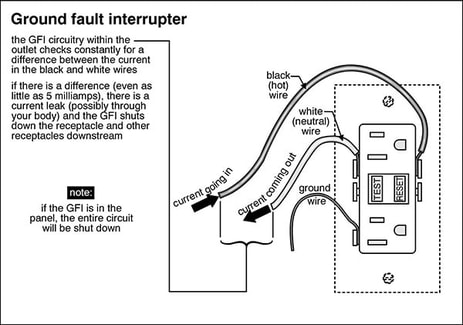For this week and next week’s blogs, I will be looking at GFCI outlets. I will discuss how they work, why they are needed, where they are needed, and how you can test GFCI outlets in your home.
Before we jump into GFCI outlets, we need to talk a little bit about wiring. In an electrical system, there are 2 wires that normally carry current. One of the wires makes the connection to the earth. This wire is considered a grounded conductor (not to be confused with the ground wire) and the other wire is considered an non-grounded conductor. The grounded conductor is (usually) the white wire and is referred to as the “neutral” wire. The non-grounded conductor can be any color other than white or green, although it is usually black. It is referred to as the “hot” wire.
Electricity’s goal always has been and always will be to find its way back to the earth. This is what causes lights to illuminate and other electrical devices to function. Electricity travels from the “hot” wire through a light or other electrical device and back to earth through the “neutral” wire. This inherent property of electricity is also what makes it a safety hazard.
Electricity can’t differentiate between a light bulb and a human being. If you provide electricity a path to ground through your body, it will pass through it just the same as a light bulb. When electricity finds its way to ground in a manner that it wasn’t supposed to, such as through your body, this is known as a ground fault. Wet areas in the home such as the kitchen and bathroom are prime locations for shocking experiences. A wet hand holding on to a faucet while another part of the body comes into contact with faulty wiring could spell disaster. This is where the GFCI outlet proves its worth.

A Ground Fault Circuit Interrupter, GFCI for short, is an electrical safety device designed to prevent fatal electrical shocks due to ground faults. A GFCI device monitors the electricity coming in and compares it to the electricity going back out through the grounded conductor. When the GFCI outlet senses a difference of as low as 5 milliamps (.005 amps), it shuts down or “interrupts” the circuit within milliseconds as a ground fault is most likely occurring. It’s not so fast that you won’t feel a shock at all, but it will prevent a fatal electrocution.

GFCI outlets requirements in the residential setting first appeared in 1971. They were first required to be installed near swimming pool equipment. Fast forward to today, and GFCI outlets are required to be installed in the areas of the home where shocks are most likely to occur, wet areas and areas where ground contact opportunities are best. This includes garages, exterior outlets, bathrooms, kitchen countertops/islands, basements, crawlspaces, and outlets within 6 feet of plumbing fixtures. Click here to see a great chart that illustrates when GFCI outlets became required in each respective area of the home.
That’s a good stopping point. Next week I will talk about different types of GFCI devices, common installation practices, and how you can test the GFCI outlets in your home.

